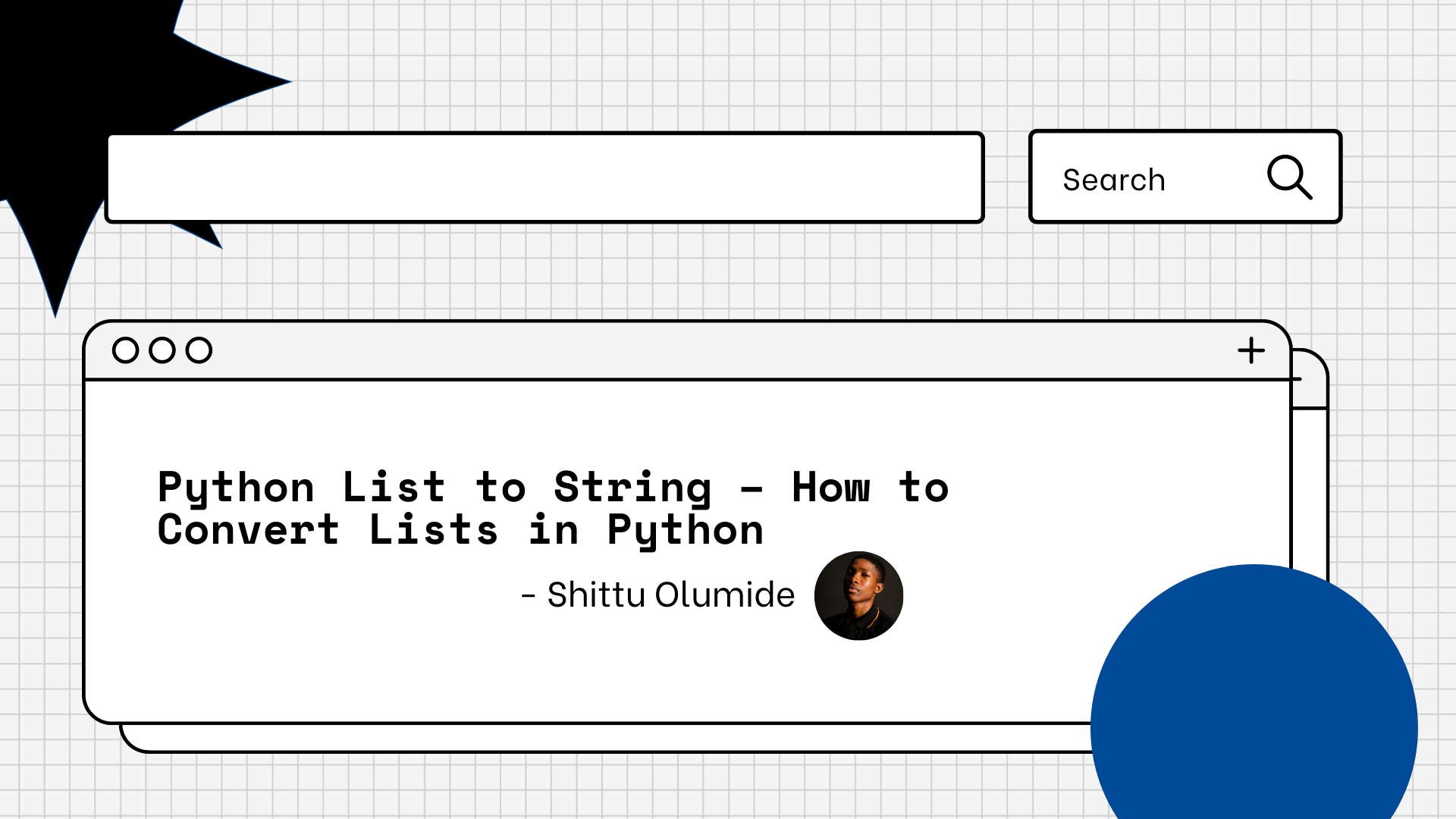Python List to String – How to Convert Lists in Python
Shittu Olumide
Whether you need to save a list as a text file, display it in a user-friendly format, or pass it as a parameter to a function, knowing how to convert a list to a string is essential.
In this tutorial, we will explore various methods to convert Python lists to strings. I’ll give you step-by-step instructions for each method, ensuring that you can easily follow along regardless of your programming expertise.
By the end of this guide, you will have a solid understanding of multiple techniques and be able to choose the one that best suits your needs.
Method 1: Using the join() method
The join() method is a powerful tool in Python for converting a list to a string. It allows you to concatenate all the elements of a list into a single string with a specified delimiter.
Here’s how you can use the join() method to convert a Python list to a string:
Create a list with elements: Start by defining a list that contains the elements you want to convert to a string. For example, let’s say we have a list of numbers: my_list = [1, 2, 3, 4, 5] .
Use the join() method to convert the list to a string: To convert the list to a string, call the join() method on the delimiter string and pass the list as an argument. For instance, to convert the list my_list to a string separated by commas, use the following code:
my_string = ",".join(str(element) for element in my_list) Specify the delimiter to join the elements: In the join() method, you can specify the delimiter that separates the elements in the resulting string. In the previous example, we used a comma («,») as the delimiter. You can use any character or string as the delimiter based on your requirements.
Store the converted string in a variable: Assign the converted string to a variable of your choice. In the previous example, we stored the converted string in the variable my_string . You can then use this variable in your code for further processing or display.
Method 2: Using list comprehension and the str() function
To convert a Python list to a string using list comprehension and the str() function, you can follow these steps:
Create a list with elements: Start by defining a Python list containing the elements you want to convert to a string. For example, let’s consider a list of numbers:
Use list comprehension to convert each element to a string: List comprehension allows you to iterate over each element in the list and apply a specific operation to it.
In this case, you want to convert each element to a string. You can achieve this by using the str() function within the list comprehension syntax:
string_list = [str(element) for element in my_list] In the above code, str(element) converts each element in my_list to a string.
Combine the converted elements into a single string using the join() method: Now that you have a new list string_list , you can join its elements into a single string using the join() method.
The join() method is called on the string that you want to use as a delimiter between the elements. For instance, if you want to separate the elements by commas, you can use «, » as the delimiter:
delimiter = ", " result_string = delimiter.join(string_list) In this case, result_string will contain the final string representation of the list, with elements separated by commas.
my_list = [1, 2, 3, 4, 5] string_list = [str(element) for element in my_list] delimiter = ", " result_string = delimiter.join(string_list) print(result_string) Running this code will output:
That’s how you can use list comprehension and the str() function to convert a Python list to a string. Remember, this method provides flexibility and allows you to customize the delimiter used to join the elements.
Method 3: Using the map() and str() functions
To convert a Python list to a string using the map() and str() functions, you can follow these steps:
Create a list with elements: Start by defining a list containing the elements you want to convert to a string. For example:
Use the map() function to convert each element to a string: The map() function applies a given function (in this case, the str() function) to each element in the list. It returns an iterator with the converted values. Apply the str() function to each element using map() like this:
converted_list = map(str, my_list) Combine the converted elements into a single string: The map() function returns an iterator, so you need to join the elements to form a string. You can use the join() method with an empty string as the delimiter to combine the elements:
result = ''.join(converted_list) Print or use the resulting string: You can now print the result variable to see the converted list as a string or use it for further processing.
Here’s the complete code snippet:
my_list = [1, 2, 3, 4, 5] converted_list = map(str, my_list) result = ''.join(converted_list) print(result) By using the map() function with the str() function, you can easily convert each element of a list to a string and then combine them into a single string. This method is particularly useful when you have a large list and want a concise way to convert it to a string.
Method 4: Using the str.join() method with a generator expression
To convert a Python list to a string using the str.join() method with a generator expression, you can follow these steps:
Create a list with elements: Begin by creating a list with the elements you want to convert to a string. For example:
my_list = ['apple', 'banana', 'cherry'] Use a generator expression to convert each element to a string: A generator expression allows you to iterate over each element in the list and convert it to a string on the fly. You can enclose the generator expression within parentheses and use the str() function to convert each element. For example:
generator_expr = (str(element) for element in my_list) Combine the converted elements into a single string using the str.join() method: Now, you can use the str.join() method on the string you want to use as a separator. Call the join() method on the separator string and pass the generator expression as an argument. For example, to join the elements of the list with a comma separator:
separator = ', ' result_string = separator.join(generator_expr) The result_string will contain the converted list elements joined together as a single string using the specified separator.
Here’s the complete code example:
my_list = ['apple', 'banana', 'cherry'] generator_expr = (str(element) for element in my_list) separator = ', ' result_string = separator.join(generator_expr) print(result_string) # Output: apple, banana, cherry Using the str.join() method with a generator expression provides an efficient and concise way to convert a Python list to a string, especially when dealing with large lists or memory limitations.
Conclusion
In conclusion, we have explored various methods to convert Python lists to strings. Let’s recap the different methods discussed in this article:
- Method 1: Using the join() method — This method involves using the join() method to concatenate the elements of a list into a single string. By specifying a delimiter, we can control the formatting of the resulting string.
- Method 2: Using list comprehension and the str() function — List comprehension allows us to iterate over each element of the list and convert it to a string using the str() function. We can then join these converted elements into a string.
- Method 3: Using the map() and str() functions — The map() function enables us to apply the str() function to each element of the list, converting them into strings. We can then use the join() method to merge the converted elements into a single string.
- Method 4: Using the str.join() method with a generator expression — Generator expressions offer an efficient and concise way to convert each element of the list to a string. By combining the generator expression with the str.join() method, we can convert the list into a string.
As you continue to develop your Python skills, I encourage you to explore other aspects of working with lists and strings.
Python offers a wide range of built-in methods and functions that can help you manipulate and transform data efficiently. With practice and experimentation, you will gain a deeper understanding of Python’s capabilities and become a more proficient programmer.
Let’s connect on Twitter and on LinkedIn. You can also subscribe to my YouTube channel.

